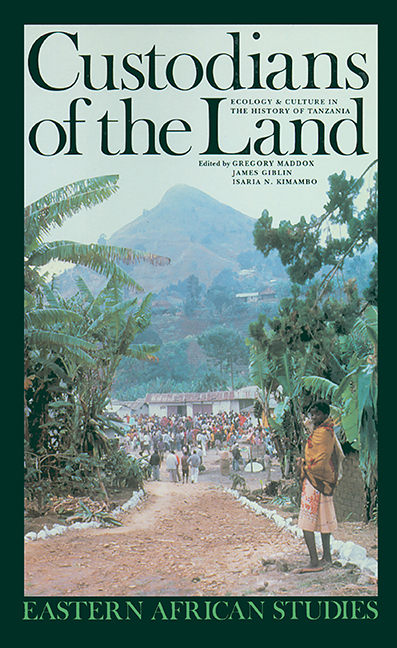Book contents
- Frontmatter
- Contents
- List of Maps, Figures & Tables
- List of Photographs
- Abbreviations
- Contributors
- Acknowledgements
- Introduction Custodians of the Land: Ecology & Culture in the History of Tanzania
- Part One Environmental & Demographic Change
- Part Two Environmental Change & Economic History: In Tanzania's Northern Highlands
- Three Environmental Control & Hunger: In the Mountains & Plains of Northeastern Tanzania
- Four Nature Reorganized: Ecological History in the Plateau Forests of the West Usambara Mountains 1850-1935
- Part Three Politics & Environmental Change
- Part Four Environment & Morality
- Conclusion
- Bibliography
- Index
Three - Environmental Control & Hunger: In the Mountains & Plains of Northeastern Tanzania
from Part Two - Environmental Change & Economic History: In Tanzania's Northern Highlands
Published online by Cambridge University Press: 30 August 2017
- Frontmatter
- Contents
- List of Maps, Figures & Tables
- List of Photographs
- Abbreviations
- Contributors
- Acknowledgements
- Introduction Custodians of the Land: Ecology & Culture in the History of Tanzania
- Part One Environmental & Demographic Change
- Part Two Environmental Change & Economic History: In Tanzania's Northern Highlands
- Three Environmental Control & Hunger: In the Mountains & Plains of Northeastern Tanzania
- Four Nature Reorganized: Ecological History in the Plateau Forests of the West Usambara Mountains 1850-1935
- Part Three Politics & Environmental Change
- Part Four Environment & Morality
- Conclusion
- Bibliography
- Index
Summary
Introduction
In the Usambara, Upare and Kilimanjaro highlands of northeastern Tanzania, as in many other African societies, the same term covers a range of meanings from hunger to life-threatening famine. The cognates which expressed these meanings in the northeastern highlands were njaa in Chagga, dhaa in Pare and saa in Shambaa. In the sense of famine, they denoted a phenomenon which was rare in the highlands. In the sense of chronic hunger or impoverishment, however, they denoted factors which drove the communities of the region to search for ways of controlling their environments. Their effort to achieve control of their environment led highland communities to interact with one another and with neighbouring groups in the surrounding lowlands.
Usambara and Upare are ranges of mountains, the Shambaa block being higher and more consolidated than the Pare mountains, which are broken into three separate blocks. Kilimanjaro, on the other hand, is a volcanic mountain rising to 19 140 feet above sea level, an altitude which makes it the tallest mountain in Africa. The inhabitants of these mountains (the Shambaa of Usambara, the Pare of Upare and the Chagga of Kilimanjaro) generally preferred to live on the high ground at altitudes of 3 500 to 6 000 feet, far above the lowlands called nyika which they considered unsuitable for residence. The Pare preferred the high plateaux of their mountain blocks, except the Shengena mountain in the south Pare block which rises to 8 000 feet above sea level. The Shengena area above 6 000 feet remained forested, as did similar areas on the Usambara block and also the area between 6 000 and 10 000 feet on Kilimanjaro.
Preference for high-altitude residence, therefore, is the first element which the inhabitants of these environments had in common before the nineteenth century. Many explanations can be given for this preference. In contrast to the surrounding nyika, there was more rain, more water and there were therefore better possibilities for producing food on the mountains. Life there was also healthier. Highlanders recognized the danger of living in the nyika, where one could become sick with mkunguru (Pare) or iseng'u (Chagga), that is, fever. Hence for centuries, people have migrated from the lowlands to the mountains in pursuit of these environmental advantages. Indeed, migrants often cite famine in the lowlands as the cause of their movements.
- Type
- Chapter
- Information
- Custodians of the LandEcology and Culture in the History of Tanzania, pp. 71 - 95Publisher: Boydell & BrewerPrint publication year: 1996



